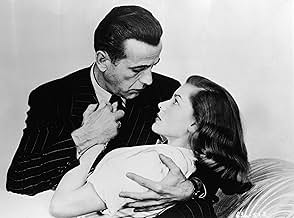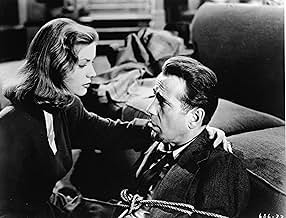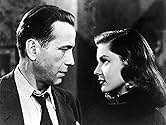Philip Marlowe, ex poliziotto e investigatore privato di Los Angeles, viene convocato da un vecchio milionario per indagare sul ricatto subito dalla figlia minore. Il detective verrà presto ... Leggi tuttoPhilip Marlowe, ex poliziotto e investigatore privato di Los Angeles, viene convocato da un vecchio milionario per indagare sul ricatto subito dalla figlia minore. Il detective verrà presto coinvolto in un intrigo misterioso e complicatissimo.Philip Marlowe, ex poliziotto e investigatore privato di Los Angeles, viene convocato da un vecchio milionario per indagare sul ricatto subito dalla figlia minore. Il detective verrà presto coinvolto in un intrigo misterioso e complicatissimo.
- Regia
- Sceneggiatura
- Star
- Premi
- 2 vittorie totali
- Art Huck
- (non citato nei titoli originali)
- Taxi Driver
- (non citato nei titoli originali)
- Max
- (non citato nei titoli originali)
- Waitress
- (non citato nei titoli originali)
- Casino Patron
- (non citato nei titoli originali)
- Waitress
- (non citato nei titoli originali)
Recensioni in evidenza
Hawks fashioned this, part of the Bogart legend, with a noire script penned by William Faulkner, et al., adapted from Raymond Chandler's first novel, that sparkled with spiffy lines, intriguing characters, danger and a not entirely serious attention to plot detail. Hawks surrounded Bogey with admiring dames, beginning with the sexy Martha Vickers who tries to jump into his lap while he's still standing (as Marlowe tells General Sternwood), and ending with the incomparable Lauren Bacall, looking beguiling, beautiful and mysteriously seductive. In fact, every female in the cast wants to get her hands on Bogey, including a quick and easy Dorothy Malone, bored in her specs while clerking at a book store. Hawks also employed some very fine character actors, most notably Elisa Cook Jr., and Bob Steele, the former as always, the little guy crook, (Harry Jones), and the latter, as often seen in westerns, the mindless heavy with a gun (Canino). Charles Waldron played the world-weary general and Charles D. Brown was the butler.
I was reminded somehow of the old Charlie Chan movies with the dark, mysterious, ornately-decorated interiors heavily carpeted and studded with ethnic statuettes, especially the house on Laverne Terrace that Bogey keeps coming back to, and the glass-paned doors and glass-separated cubicals of his office and others. The atmospheric L.A. created here has been much admired and imitated, cf., Chinatown (1974) and L.A. Confidential (1997), two very superior movies that continued the tradition.
In comparing this to the book, I have to say it's a little on the white-washed side, and not as clearly drawn--'confused' some have said. Of course liberties were taken with Chandler's novel to make it romantic. Chandler's novel emphasizes cynicism, and romance takes a back seat to manliness and loyalty to the client. An especially striking difference is in the character of General Sternwood's younger daughter, Carmen. She is vividly drawn in the book as something of monster, a degenerate sex kitten who would try and do just about anything. She is twice encountered butt naked by Marlowe, once in his bed. Being the sterling guy he is, he turns her away. (Right. I could do that.) Another difference is in all the sleazy details about the low-life underworld of Los Angeles that are omitted or glossed over in the film, including Geiger's homosexuality and his gay house guest, Carol Lundgren. (Of course there was a code in those days.) Bacall's character in the movie is actually a fusion of Vivian and Mona Mars from the book, made nice for movie fans. In the book, Marlowe kisses Vivian, but turns down her invitation for more intimate contact. In the movie, of course, there is no way Bogart is going to say 'no' to Bacall. In the book Marlowe seems to prefer whiskey to women.
Most of the sharp dialogue comes right from Chandler's novel, including Bogart's grinning line, 'Such a lot of guns around town, and so few brains.' Interesting is the little joke on Bogart in the opening scene. In the novel, Chandler's hero is greeted by the purring Carmen with the words, 'Tall, aren't you?' Well, the one thing Bogey ain't is tall, and so in the movie Carmen says, 'You're not very tall, are you?' Bogart comes back with, 'I try to be.' In the novel, Marlowe says, 'I didn't mean to be.'
By the way, the film features Bacall singing a forties tune and looking mighty good doing it.
(Note: Over 500 of my movie reviews are now available in my book "Cut to the Chaise Lounge or I Can't Believe I Swallowed the Remote!" Get it at Amazon!)
Even hardened film noir and Humphrey Bogart fans admit that this is one confusing movie. It makes sense, but it is edited down to such essentials, and it barrels along with the intensity of a bullet in a smoky canyon using overlapping dialog e and a shower of names, half of whom end up dead, it's really an impossible job for a mortal viewer.
And that's where it's aura, and magic, and legend, lie. It's a great film, and if it's flawed by its excessive velocity, it's defined by it, too. Enjoy Bogart as such, and Lauren Bacall for her sporadic appearances, and for Elisha Cook Jr. for a brief, wonderful splash. All the side characters, even the ones who are clearly only characters, are dripping with criminal drama. The photography is dark but never obscure, the action is fast but never unreasonable, and the lines are classic noir.
In fact, the dialog, if you are paying attention, is one of the gems of 1940s movies--really witty and cutting, and cunning. The movie is brilliant top to bottom, if only you could keep track of what was going on.
Suggestions: Read the plot in the Wikipedia entry before you watch the movie a second time. (The first time, just dive and and get lost. It's too much fun to care, if you can let go.) Watch Bogart's delivery, his physical presence, his wherewithal. Listen to Bacall sing (pretty darned good). Watch the amazing light and camera work (Sydney Hickox) with it's constantly moving perspective and layers of action. Follow the score (Max Steiner) which is appropriately restrained, turning just slightly when Bogart and Bacall are in scenes together.
Howard Hawks pulls of a quirky masterpiece here. You get to the end and frankly don't care too much, perhaps, about the outcome, about who survives and what their futures might hold. But that's fine, too. It might just make you want to watch it again. Good filmmaking does that.
Humphrey Bogart and Lauren Bacall are certainly persuasive in their roles. I also like the script's snappy dialogue. For example, in a conversation with General Sternwood, Marlowe responds: "Hmm". Sternwood follows up: "What does that mean?" To which Marlowe fires back: "It means, hmm". Marvelous.
But the film's plot is an incoherent mess. It is hard to follow, disjointed, and has obvious lapses. Further, secondary characters (Geiger, Brody, Mars, et.al.), and their interrelationships, are poorly defined. To some extent that vagueness and lack of precision are fairly common in 1940's pulp detective stories.
The best approach to "The Big Sleep" is to engulf the relationship between Marlowe and Vivian, marvel at the acting of Bogie and Bacall, enjoy the witty dialogue, and ignore the discombobulated plot.
Despite the fact that this film is overly complicated at times, it still stands out as a classic bit of noir, even if aspects other than the plot are what really makes it as good as it is. The plot starts simply but quickly becomes a much more complex beast that moves beyond the issue of blackmail and into murder and lies. For many viewers, this will be a challenge - so many characters come and go in a short period that it is hard to keep track of how they all relate to each other, and the fact that we're not always supposed to know the connections just makes it more difficult at times. However, if you manage to make it past the midpoint of the film without having totally lost track of people then it becomes clearer towards the end. It may sound silly, but this time I watched the film with a pen and paper to help me keep track of who's who - it really helped; but it is worth noting that, even with help, bits of the plot will make little sense at times.
The focus of the film is not the plot - the focus of the film I think is the relationship dynamic between Marlowe and Vivian. In this regard the film really works well. The relationship between is tough but trusting no matter what; at times it is a little hard to see the affection between the two being real or realistic but it is the dialogue between the two that makes it work despite this. The writing is fantastic, the scenes between them do fizzle but the dialogue across the whole film is perfect: it is tough, memorable and basically it is the way I'm sure we all wish we could talk at some point in our lives! The material is also quite daring for the period - murder and tough talk was not unusual but the issues of drugs and nymphomania are hardly common subjects for such a mainstream film at the time.
The performances are fantastic and perfectly fit the material. Although this is not my favourite Bogart performance (I love him in Maltese Falcon) he is still brilliant here, he is cool, tough and intelligent - at times his power over women threatens to be unrealistic but his presence makes it work. His character is not as complex as in Maltese Falcon but Bogart does harried and world-weary better than anyone else. Bacall is great even if I don't personally find her that attractive; she has a great chemistry with Bogart and delivers the goods. Vickers is also good but in a less subtle role. The support cast includes tough turns from Cook, Heydt and Ridgely all of whom convince as tough guys but not to the point where they threaten to eclipse the shining star of Bogart.
Overall this is a classic film despite the fact that the plot is too difficult at times and doesn't always hang together. The flaws here are covered by a tough script that delivers the goods in terms of both dialogue and characters. The plot is a complex web but the basic energy and relationship dynamics keep the film moving really well through scenes that continue to show their influence in films today. Not a perfect film but a great bit of noir that is likely to be loved by the vast majority of viewers - just keep that pen and paper to hand though!
Initially, private detective Philip Marlowe (Bogart) is summoned to the Sternwood mansion by General Sternwood who wants Marlowe to resolve his daughter Carmen's gambling debts. But soon Marlowe is caught in a web of murder, extortion, pornography, love triangles, organized crime, and missing persons. No wonder the plot is convoluted. It would have to be so to get past the production code! All along , everyone is telling Marlowe all events resolve around Regan, but Marlowe didn't care. Instead what everyone cares about is that the Bogie and Bacall characters can live on and develop that sizzling relationship in peace. Warner Bros capitalized on the PR aspect of the event of releasing this film and made it less dark and a lot more romantic than the source material and who-killed-who became a side show instead of the core of the film.
What with Marlowe flirting or more than flirting with a book store proprietor, an eager cabby, Vivian Sternwood and her thumb sucking sister (even little Jonesy winked at him once, didn't he?), I'm surprised the private eye had the chance to solve any crimes at all. Bogart's Marlowe was sort of a '40s forerunner to James Bond as a chick magnet. It was adolescent male fantasizing, Warners style. Not only that but this Marlowe was clever enough to indulge in racetrack double entendres with a glamorous, sophisticated looking babe like Lauren Bacall. No wonder viewers aren't terribly concerned if they can figure out the convoluted plot when they can have fun, sexy times with this particular noir crowd.
So stick with this for the clever dialogue, for the atmosphere, for the weird characters, and most of all the chemistry that is Bogart and Bacall. Everything else is just window dressing.
Lo sapevi?
- QuizDue to Humphrey Bogart's affair with co-star Lauren Bacall, his marital problems escalated during filming, and his drinking often resulted in his being unable to work. Three months after the film was finished, Bacall and Bogart were married.
- BlooperWhen Marlowe enters the Sternwood home, bringing Carmen Sternwood home from Geiger's house, he is not wearing his trench coat. But, as he leaves, he is given the coat by Norris, the butler, and puts it on.
- Citazioni
Philip Marlowe: She tried to sit on my lap while I was standing up.
- Curiosità sui creditiDuring the opening credits, Humphrey Bogart and Lauren Bacall are seen in silhouette, placing cigarettes in an ashtray. At the end, two cigarettes are in an ashtray.
- Versioni alternativeIt was filmed in 1944 but not released until two years later. Some prints derive from a slightly different early preview version with alternate footage.
- ConnessioniEdited into La trappola mortale (1965)
- Colonne sonoreAnd Her Tears Flowed Like Wine
(uncredited)
Music by Stan Kenton and Charles Lawrence
Lyrics by Joe Greene
Sung by Lauren Bacall and The Williams Brothers
[A band accompanies Vivian singing the song at the casino]
I più visti
Dettagli
- Data di uscita
- Paese di origine
- Sito ufficiale
- Lingua
- Celebre anche come
- Al borde del abismo
- Luoghi delle riprese
- Azienda produttrice
- Vedi altri crediti dell’azienda su IMDbPro
Botteghino
- Budget
- 250.000 USD (previsto)
- Lordo Stati Uniti e Canada
- 25.556 USD
- Lordo in tutto il mondo
- 51.050 USD
- Tempo di esecuzione1 ora 54 minuti
- Colore
- Proporzioni
- 1.37 : 1
Contribuisci a questa pagina




































